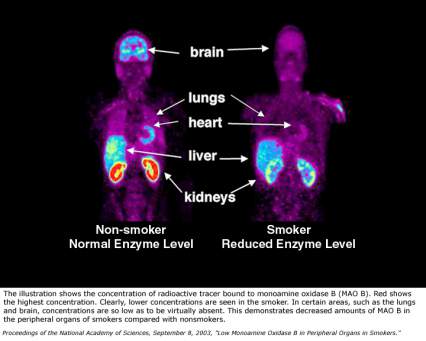It is well known that smoking cigarettes can directly and often fatally damage the lungs. But new research, with support from the National Institute for Biomedical Imaging and Bioengineering and the National Institute on Drug Abuse, National Institutes of Health, and the Department of Energy, shows that cigarette smoke also decreases levels of a critical enzyme called monoamine oxidase B (MAO B) in the kidneys, heart, lungs, and spleen. Too much or too little of this crucial enzyme can have an effect on a person's mental or physical health.
MAO B is important because it breaks down the chemicals that allow nerve cells to communicate and regulate blood pressure.
PET, or positron emission tomography, employs computer technology and radioactive compounds to produce images of biochemical processes within living systems.
"Smoking is a major public health problem that results in approximately 440,000 deaths per year in the United States alone," says NIH Director Dr. Elias Zerhouni. "This new finding highlights the fact that the act of smoking cigarettes can affect biochemical systems within multiple organs other than the lungs and upper airways."
"When we think about smoking and the harmful effects of smoke, we usually think of the lungs and of nicotine," says NIDA Director Dr. Nora D. Volkow, one of the authors of the study. "But here we see a marked effect on a major body enzyme in sites far removed from the lungs that we know is due to a substance other than nicotine. This alerts us to the fact that smoking, which is highly addictive, exposes the whole body to the thousands of compounds in tobacco smoke."
Dr. Joanna Fowler, together with Dr. Volkow and others at Brookhaven National Laboratory and the State University of New York at Stony Brook, conducted the study, which will be published online during the week of September 8 on the Proceedings of the National Academy of Sciences Web site.
Dr. Fowler and the research team compared PET scans showing MAO B activity in 12 smokers with scans from 8 nonsmokers. The researchers observed that MAO B activity in the peripheral organs was reduced by one-third to almost one-half in smokers compared with nonsmokers.
The scientists caution that the effects of this finding remain unknown at present. "The consequences of reduced levels of this important enzyme need to be examined in greater detail," explains Dr. Fowler. "Though we do not know the physiological effects of such a reduction in MAO B in peripheral organs, we do know we need the enzyme to break down blood pressure-elevating chemical compounds in certain foods, as well as those that are released by nicotine. Thus, it is possible that lower levels of this enzyme in peripheral organs could have medical consequences."
Previous research by these scientists has shown that the level of MAO B is lower in the brains of smokers.
The study also was funded by the Office of National Drug Control Policy.
 The illustration shows the concentration of radioactive tracer bound to monoamine oxidase B (MAO B). Red shows the highest concentration. Clearly, lower concentrations are seen in the smoker. In certain areas, such as the lungs and brain, concentrations are so low as to be virtually absent. This demonstrates decreased amounts of MAO B in the peripheral organs of smokers compared with nonsmokers. Proceedings of the National Academy of Sciences, September 8, 2003, "Low Monoamine Oxidase B in Peripheral Organs in Smokers."
The illustration shows the concentration of radioactive tracer bound to monoamine oxidase B (MAO B). Red shows the highest concentration. Clearly, lower concentrations are seen in the smoker. In certain areas, such as the lungs and brain, concentrations are so low as to be virtually absent. This demonstrates decreased amounts of MAO B in the peripheral organs of smokers compared with nonsmokers. Proceedings of the National Academy of Sciences, September 8, 2003, "Low Monoamine Oxidase B in Peripheral Organs in Smokers."